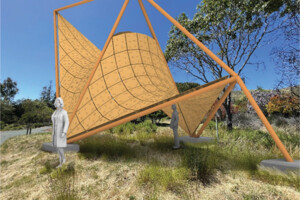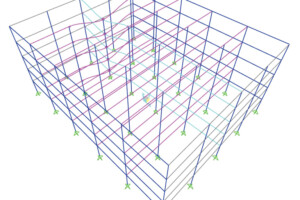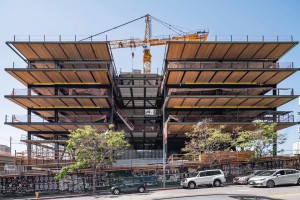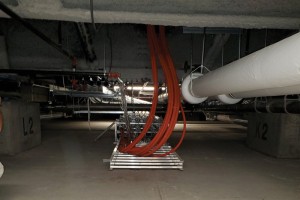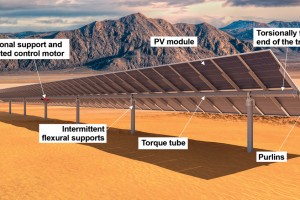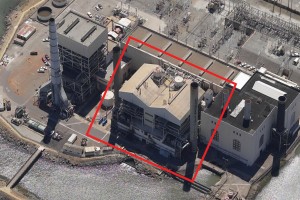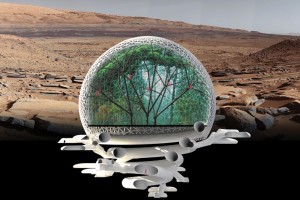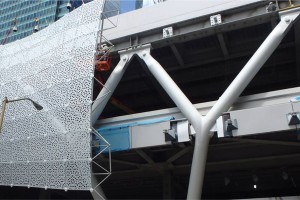Unleashing creativity within constraints.
…Review Category : Outside the Box
Simplicity in the face of uncertainty.
…Recently, it became fairly apparent that construction cost of affordable housing – using current building codes and models – is quite high on a unit cost basis. This cost issue reduces the number of units available and makes them prohibitively expensive for many potential buyers. However, current knowledge enables construction of multi-story concrete flat plate buildings of optimum cost. Typically, sixty to eighty percent of structural concrete volume in a multi-story flat plate building goes in slabs. In the U.S., it is typical for multi-story residential buildings to be post-tensioned concrete construction, typically with 8 inch (203 mm) thick slabs spanning up to 30 feet (9.1 m) between columns and/or bearing walls. This framing system layout provides architects with flexibility in room and unit layout on a given floor, and in adjacent stories, since the unit walls are not required to stack, as is the case in economical multi-story wood frame construction. Structural engineers have long known that greater number of columns reduces both the slab spans and the overall cost of construction; shorter spans allow for using thinner slabs.
…First use of CLT in the Los Angeles Area
843 N Spring Street is a multi-use creative office and retail/restaurant space and the first mass timber project with cross-laminated timber (CLT) to be constructed in the Los Angeles area. It was fundamental gaining acceptance of CLT as a viable structural material under City of Los Angeles Building Code, and is presented as a case study for the sustainable benefits of adaptive reuse integrated with lightweight structures.
…The Age of IoT (Internet of Things) has come much sooner than anticipated. The pandemic accelerated the digital transformation process, requiring everyone to be comfortable with technology: fast internet, video conferences, cloud storage, and VPN tunnels. Data center facilities housing servers, switches, data storage, and computer processing functions are also becoming more common as major businesses become more reliant on the cloud (Figure 1). Two common types are colocation and hyperscale. Colocation facilities can serve multiple tenants, while hyperscale facilities typically serve a single tenant. Hyperscale facilities are commonly developed by tenants or with significant involvement from the eventual tenant. The design for colocation facilities is based on a developer’s best guess of what the market and potential tenants would want in a particular location.
…Analysis and Design
Renewable power generation nearly doubled in the past decade, growing from 382 million MegaWatt hours (MWh) in 2008 to 742 million MWh in 2018, contributing approximately 18% of total power generated in the United States in 2018. 13% (96 million MWh) of the total renewable power is solar from both small-scale and utility-scale installations. …
An Investigation into Demolition of Complex Structures
Scarcity of buildable land, aging infrastructure, and changes in urban environments create an increasing demand for the demolition of existing structures. Often, demolition is planned and executed by a demolition contractor relying on experience and judgment for techniques and sequencing. Appropriate for some types of structures, such as small residential buildings with large offsets from surrounding structures, demolition plans not prepared by an engineer may not be appropriate for larger and more complex structures, where the consequences of unforeseen structural behavior during demolition can be dramatic or even fatal. …
Engineering Habitats for the Moon and Mars
Several decades after the first space age, there is renewed interest in space exploration and specifically in future human habitation far beyond the Earth’s surface. NASA recently received funding with an ambitious target: to send a manned mission to Mars by the 2030s and allow for future human habitats and even cities. …
Remarkable, Signature or Great Bridges?
Mankind has been building bridges since the time of early civilizations. Today, bridges are all around us – they provide easier, faster, and safer connections between two points. Bridges have evolved from merely utilitarian structures to become symbols of cities, countries, and human progress. …

